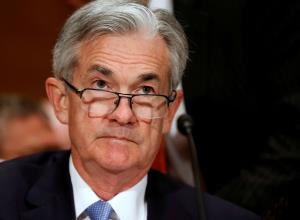
Fed Chairman Jerome Powell
Last week Federal Reserve Chairman Jerome Powell submitted his semiannual monetary policy report to Congress. Mr. Powell convinced Congress the economy was not overheating, yet voiced there was still a need for gradual rate hikes. Financial markets were volatile on the strength of his comments. For the week the Dow Jones (DIA), S&P 500 (SPY) and the Nasdaq (QQQ) finished down 3%, 3%, and 2%, respectively. Below are highlights from Chairman Powell's comments and my interpretation.
Strong Jobs Growth
Chairman Powell
The U.S. economy grew at a solid pace over the second half of 2017 and into this year. Monthly job gains averaged 179,000 from July through December, and payrolls rose an additional 200,000 in January. This pace of job growth was sufficient to push the unemployment rate down to 4.1 percent, about 3/4 percentage point lower than a year earlier and the lowest level since December 2000. In addition, the labor force participation rate remained roughly unchanged, on net, as it has for the past several years--that is a sign of job market strength, given that retiring baby boomers are putting downward pressure on the participation rate. Strong job gains in recent years have led to widespread reductions in unemployment across the income spectrum and for all major demographic groups.
My Interpretation
The 200,000 jobs added in January confirmed the economy is at a fever pitch. It also appears to confirm that the Federal Reserve has done its job over the past decade by helping to create a wealth effect in stocks and keeping interest rates at record low levels. Construction, leisure & hospitality were particularly strong. Construction could stall in a rising interest rate environment. Leisure and hospitality could connote that jobs serving the wealthy - big beneficiaries of the Fed's wealth effect - are areas of growth.
A 4.1 percent unemployment rate suggests the economy is at or above full-employment and at risk of overheating. Powell's reference to the labor force participation rate was also telling. January's labor force participation rate of 62.7 percent has been flat over the past four years. Prior to that it had not been this consistently low since the late 1970s when President Carter was in office. If retiring baby boomers have hurt the metric then the low labor participation rate could potentially improve over time.
Moderate Wage Growth
Chairman Powell
Wages have continued to grow moderately, with a modest acceleration in some measures, although the extent of the pickup likely has been damped in part by the weak pace of productivity growth in recent years.
My Interpretation
Hourly wages in January 2017 were up 2.9% Y/Y. It was the fastest pace of wage growth since 2009 and topped forecasts of 2.7%. Fearing the Fed would use wage growth as a reason to hike rates, financial markets sold off after the February jobs report was released. The Dow Jones fell by 8% in early February. Fears that the Fed could get behind the curve if it waited too long to raise rates drove chatter of three or four rate hikes in 2018. The fact that Powell described wage growth as "moderate" could imply the Fed is more focused on personal consumption expenditures ("PCE") as the major catalyst to either hike rates or stay the course.
Gradual Rate Hikes
Chairman Powell
In gauging the appropriate path for monetary policy over the next few years, the FOMC will continue to strike a balance between avoiding an overheated economy and bringing PCE price inflation to 2 percent on a sustained basis ... In the FOMC's view, further gradual increases in the federal funds rate will best promote attainment of both of our objectives. As always, the path of monetary policy will depend on the economic outlook as informed by incoming data.
My Interpretation
Chairman Powell wants to avoid an overheating economy. If record low interest rates for nearly a decade are working then they should able to stimulate the economy. The low unemployment rate and pick up in wage growth suggest the economy is picking up. President Trump's tax cut could potentially be a tailwind if corporations share their boon in cash flows with workers. From that perspective gradual rate hikes would be warranted, lest the Fed risks falling behind the inflation curve.
However, Powell also wants to bring PCE to 2 percent on a sustained basis. PCE was 1.7% in 2017 and has not reached 2 percent since Ben Bernanke was Fed Chairman. The caveat appears to be that Powell is prepared to hike rates, but only if PCE reaches or exceeds 2 percent for a few quarters. I will believe it when I see it.



